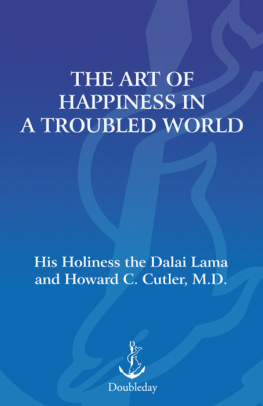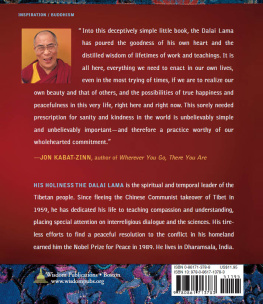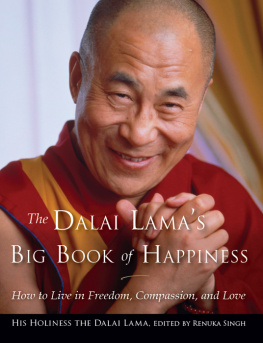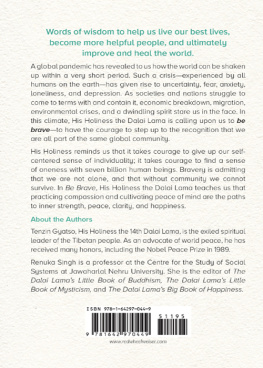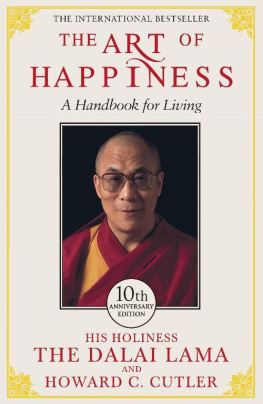
ABOUT THE AUTHORS
His Holiness the Dalai Lama was born on July 6, 1935, to a poor farming family in northeastern Tibet. At the age of two he was recognized as the Dalai Lama, the spiritual and temporal leader of Tibet, the fourteenth in a succession dating back 600 years. At the age of six he began his lifelong training as a Buddhist monk. Since 1959 the Dalai Lama has lived in exile in Dharamsala, India, after escaping Tibet following an unsuccessful uprising by the Tibetan people against the occupation of Tibet by Chinese forces. His tireless efforts on behalf of human rights, world peace, and basic human values have brought him international recognition. He is the recipient of numerous honors and awards, including the 1989 Nobel Prize for Peace, and the U.S. Congressional Gold Medal.
When asked about his role in life, the Dalai Lama will often refer to himself as a simple Buddhist monk. Many others consider him to be one of the foremost spiritual leaders of our time and one of the worlds leading Buddhist scholars and teachers. During the course of his extensive travels he also speaks as a passionate advocate for his three main commitments in life: First, he is committed to the promotion of basic human values, or what he often refers to as secular ethics. Second, he is committed to the promotion of harmony and understanding among the worlds major religious traditions. And third, he is committed to the Tibet issue, dedicated to the welfare of the Tibetan people, acting as a spokesperson in their struggle for greater human rights, autonomy, and freedom. Wherever he goes, the Dalai Lama makes a sincere appeal to his audience for greater kindness, compassion, tolerance, and universal responsibility.
For more information about the Dalai Lama, including his schedule of teachings, please visit: www.dalailama.com

Howard C. Cutler, MD, is a psychiatrist, bestselling author, and speaker. He is co-author with His Holiness the Dalai Lama of the acclaimed Art of Happiness series of books, which have been translated into fifty languages and have appeared on bestseller lists throughout the world. The groundbreaking first volume, The Art of Happiness: A Handbook for Living, appeared on The New York Times Bestsellers list for ninety-seven weeks. As a leading expert on the science of human happiness and a pioneer in the field of positive psychology, Dr. Cutler gives keynote presentations, workshops, and courses on happiness to individuals and organizations in cities throughout the United States and worldwide.
Dr. Cutlers background includes a BA in art, a BS in zoology, and an MD degree from the University of Arizona College of Medicine, followed by a four-year postgraduate training program in psychiatry. He is a diplomate of the American Board of Psychiatry and Neurology and is on the editorial board of The American Journal of Psychotherapy. Dr. Cutler has dedicated his life to helping others find greater happiness, fulfillment, and success. He currently resides in Phoenix, Arizona.
For more information about The Art of Happiness, including books, workshops, and courses, or to contact Dr. Cutler, please visit: www.theartofhappiness.com

THE ART OF HAPPINESS BOOK SERIES
The Art of Happiness: A Handbook for Living (10th Anniversary Edition) by His Holiness the Dalai Lama and Howard C. Cutler, MD. New York: Riverhead Books 2009 (original edition 1998).
The Art of Happiness at Work by His Holiness the Dalai Lama and Howard C. Cutler, MD. New York: Riverhead Books 2003.
The Art of Happiness in a Troubled World by His Holiness the Dalai Lama and Howard C. Cutler, MD. New York: Doubleday Religion 2009.

ABOUT THE ART OF HAPPINESS SERIES
The Art of Happiness book project is a series of books on the theme of human happiness, written by His Holiness the Dalai Lama and Howard C. Cutler, MD. The books examine different facets of human happiness from both the Eastern and Western perspectives, with the Dalai Lama representing the Buddhist perspective and Dr. Cutler, an American psychiatrist, representing the Western scientific perspective. Since the original publication of The Art of Happiness: A Handbook for Living in 1998, there has been a rapidly growing interest in the subject of happiness worldwide, including a new field of psychology devoted to the scientific study of human happiness and flourishing. During these years, the Dalai Lama and Dr. Cutler have continued their collaboration. Additional volumes of the Art of Happiness series are currently planned.
ME VERSUS WE
I think this is the first time I am meeting most of you. But whether it is an old friend or a new friend, theres not much difference anyway, because I always believe we are the same: We are all just human beings. H.H. THE DALAI LAMA, SPEAKING TO A CROWD OF MANY THOUSANDS
T IME PASSES . The world changes. But there is one constant I have grown used to over the years, while intermittently traveling on speaking tours with the Dalai Lama: When speaking to a general audience, he invariably opens his address, We are all the same
Once establishing a bond with each member of the audience in that way, he then proceeds to that evenings particular topic. But over the years Ive witnessed a remarkable phenomenon: Whether he is speaking to a small formal meeting of leaders on Capitol Hill, addressing a gathering of a hundred thousand in Central Park, an interfaith dialogue in Australia, or a scientific conference in Switzerland, or teaching twenty thousand monks in India, one can sense an almost palpable effect. He seems to create a feeling among his audience not only of connection to him, but of connection to one another, a fundamental human bond.
It was early on a Monday morning and I was back in Dharamsala, scheduled to meet shortly with the Dalai Lama for our first meeting in a fresh series of discussions. Home to a thriving Tibetan community, Dharamsala is a tranquil village built into a ridge of the Dauladar mountain range, the foothills of the Himalayas in northern India. I had arrived a few days earlier, around the same time as the Dalai Lama himself, who had just returned home from a three-week speaking tour in the United States.
I finished breakfast early, and as the Dalai Lamas residence was only a five-minute walk along a mountain path from the guesthouse where I was staying, I retired to the common room to finish my coffee and review my notes in preparation for our meeting. Though the room was deserted, someone had left on the TV tuned to the world news. Absorbed in my notes, I wasnt paying much attention to the news and for several minutes the suffering of the world was nothing but background noise.
It wasnt long, however, before I happened to look up and a story caught my attention. A Palestinian suicide bomber had detonated an explosive at a Tel Aviv disco, deliberately targeting Israeli boys and girls. Almost two dozen teenagers were killed. But killing alone apparently was not satisfying enough for the terrorist. He had filled his bomb with rusty nails and screws for good measure, in order to maim and disfigure those whom he couldnt kill.

